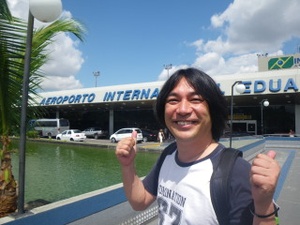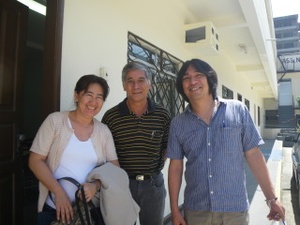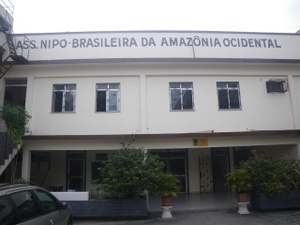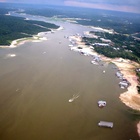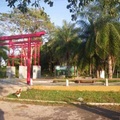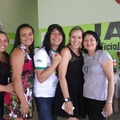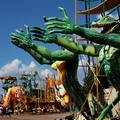After completing our pre-training in Japan, which began in March 2010, we Japanese community volunteers flew from Narita to Brazil via New York on July 1st, where we also undertook a month of on-site Portuguese language training in Sao Paulo. Once this training was over, we were finally dispatched to various locations throughout Brazil, where we began our respective activities. Our teammates set off to various parts of Brazil, including Rio de Janeiro, Campo Grande, Brasilia, and Foz do Iguaçu.
July 23rd. I left the hustle and bustle of the international city of São Paulo and safely arrived at Eduardo Gomes International Airport, the largest airport in the Amazon region. The flight took about four hours. From Japan, it's a short overseas trip away. Brazil is 23 times the size of Japan, so even traveling within the country takes quite a bit of time.
Even though it is a city in the jungle, Manaus is a modern metropolis with a population of 2 million. The city is also home to Brazil's largest industrial park, with 200 companies from around the world, including 30 from Japan. The main road stretching from the airport to the city center is well maintained, with cars, trucks, and buses passing by at a dizzying pace. The blue sky and the green palm trees lining both sides of the road are dazzling. But the ultraviolet rays are intense.
Before going to Brazil, I had checked out what Manaus was like on YouTube and other video sites, but the moment I left the airport, I was surprised by the relentless heat wave shower that hit me from the head. At the airport, I was greeted by Nishikido Sensei, the president of the Western Amazon Japan-Brazil Association, as well as Kiba-san, the secretary-general, and Takayama-san, the vice-president. Nishikido Sensei and Kiba-san are first-generation Japanese immigrants after the war, and Takayama-san is a third-generation Japanese immigrant from São Paulo.
The Japanese community in the Amazon is made up of people from a variety of backgrounds, including pre-war Amazonian immigrants, post-war Amazonian immigrants, people who moved from the states of São Paulo, Paraná, and Pará, expatriates working for Japanese companies and their families, and the staff at the Japanese schools their children attend. It is not uncommon for first-generation immigrants to marry second-generation immigrants, so the relationships between immigrants are so complex that they cannot be simply categorized as second or third generation.
I still vividly remember the day I arrived. The teachers from the Western Amazon Japan-Brazil Association held a welcome party for us. We gave a brief self-introduction and were treated to a feast of Brazilian snacks and dishes called saugadinhos, including millet, coxinha, and bustel.
At that time, there were about 500 students studying Japanese at the Japanese Language Class of the Western Amazon Japan-Brazil Association. Even in the vast country of Brazil, it is rare to find an organization with such a large number of students. Most of the students are local Brazilians and have no Japanese roots. Brazil is known as a country of immigrants, and in its history, many different races have appeared, including Indians, Portuguese, Spanish, slaves from Africa, Chinese, Italians, Germans, and Japanese. Brazilians are a mix of all of these. It is relatively easy to describe the characteristics of Japanese people as having black hair, yellow skin, and small stature, but their physical characteristics cannot be described in a single word. Some Brazilians are dark-skinned, while others are blonde and blue-eyed. It is not uncommon to also find Brazilians of Indian or Asian descent.
In the Japanese language classes at the Western Amazon Japan-Brazil Association, only about 20% of the students have Japanese roots. On the other hand, 80% of the teachers are Japanese descendants, mainly those who have worked in Japan or are children of immigrants. There are two types of classes: children's classes and adult classes. The adult classes are divided into about nine levels, from beginners to those taking the Japanese Language Proficiency Test. Each level is taught for about three hours a week, and students move up to the next level every six months. The teachers participate in training sessions held in Japan and São Paulo, and strive to make their classes easy to understand and enjoyable. "Classes don't start unless they're fun!" This is the motto of Mr. Ken Nishikido, president of the Western Amazon Japan-Brazil Association and principal of the Japanese language classes.
During the welcome party, one of the teachers sitting next to me spoke to me with a carefree smile. "Nice to meet you! I'm Honan. You're from Hamamatsu, aren't you? I used to live there too. My parents still live in Kita-ku, Hamamatsu." His family lives in Japan as migrant workers. As expected, Hamamatsu is the number one city for Brazilian residents. With that one word, I felt the connection between Manaus and Hamamatsu, and the kind smiles of the teachers made my anxieties about my new life disappear.
© 2015 Toshimi Tsuruta


